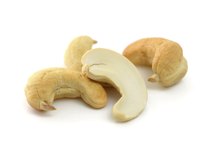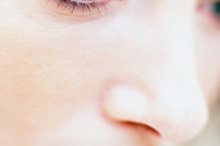How to Increase Sebum
Sebum is oil made by sebaceous glands. It collects around hair follicles and spreads to the surrounding skin 2. Sebum works together with skin lipids and sweat to create what is referred to as an acid mantle 2. An insufficient amount of sebum makes skin susceptible to bacterial and fungal infections while too much of it can result in acne 2. The proper balance both protects the skin and keeps it well hydrated 2.
Remove comedones like acne, blackheads, pimples and whiteheads. Blocked comedones won't allow skin ducts to release enough sebum, which can lead to acne, bacterial infections and other skin problems 2.
Which Nuts Are Good to Get Rid of Acne?
Learn More
Stimulate androgen production by increasing the effectiveness of the sebaceous glands. This can be achieved by using vitamins and supplements as well as by eating the right foods. Vitamins A, B1, C and E, chromium, folic acid, and Ginkgo biloba are believed to increase androgen. Supplements like L-arginine, L-tyrosine, magnesium, nitric acid, selenium, and zinc can help as well. Good food options include bananas, figs, and raw oysters that are believed to increase androgen production 2.
Work with a physician to balance estrogen and progesterone. In some cases, hormone imbalance can affect the amount of sebum produced. Children at puberty through their teen years often produce too much, which can lead to acne. Older individuals--especially women of menopausal age and beyond--find an imbalance often leads to insufficient amounts of sebum production.
How to Make Face Skin Produce Less Oil
Learn More
Use medications that increase sebum production. These include levonorgestrel, medroxyprogesterone, phenothiazines and testosterone. Avoid medications that can affect sebum production like antiandorgens, isotretinoin and oestrogen.
Eat nutritious foods believed to help sebum production. These include apricots, foods with anti-oxidants, beta-carotene, brewer’s yeast, legumes, liver, natural fruit and vegetable juices, nuts, papaya, persimmons, potatoes, sweet potatoes, wheat and whole grain products. Avoid foods that lead to the wrong type of oil production and skin inflammation 2. These include certain dairy products, foods containing iodine, processed foods, refined carbohydrates, salt, seaweed, shellfish and trans-fats.
Tips
Stay away from foods that could cause allergic reaction or clogged pores, such as alcohol, chocolate, iodine and wheat products. Drink plenty of water to keep skin pores open and to flush away toxins that can lead to skin issues. Cleanse the skin regularly to keep pores unclogged so that sebum can seep through naturally. Use all natural skin cleansers or water-based products.
Warnings
Certain illnesses like adrenal conditions, anorexia or bulimia, nodules, ovarian, pituitary and testicular conditions and Parkinson’s disease naturally decrease sebum production.
Related Articles
References
- Derm Net
- Doctor Good Skin
- Fischer H, Fumicz J, Rossiter H, Napirei M, Buchberger M, Tschachler E, Eckhart L. Holocrine Secretion of Sebum Is a Unique DNase2-Dependent Mode of Programmed Cell Death. J Invest Dermatol. 2017;137(3):587-594. doi:10.1016/j.jid.2016.10.017
- Schneider M, Paus R. Sebocytes, multifaceted epithelial cells: lipid production and holocrine secretion. Int J Biochem Cell Biol. 2010;42(2):181-5. doi:10.1016/j.biocel.2010.11.017
- Bagatin E, de Freitas T, Machado M, Ribeiro B, Nunes S, da Rocha M. Adult female acne: a guide to clinical practice. An Bras Dermatol. 2019;94(1): 62–75. doi:10.1590%2Fabd1806-4841.20198203
- Picardo M, Ottaviani M, Camera E, Mastrofrancesco A. Sebaceous gland lipids. Dermatoendocrinol. 2009;1(2):68-71. doi:10.4161%2Fderm.1.2.8472
- Lovászi M, Szegedi A, Zouboulis C, Törőcsik D. Sebaceous-immunobiology is orchestrated by sebum lipids. Dermatoendocrinol. 2017;9(1):e1375636. doi:10.1080/19381980.2017.1375636
- Zhou S, Li D, Zhou Y, Cao J. The skin function: a factor of anti-metabolic syndrome. Diabetol Metab Syndr. 2012;4(1):15. doi:10.1186/1758-5996-4-15
- Fox L, Csongradi C, Aucamp M, Du plessis J, Gerber M. Treatment Modalities for Acne. Molecules. 2016;21(8). doi:10.3390%2Fmolecules21081063
- Osterberg EC, Bernie AM, Ramasamy R. Risks of testosterone replacement therapy in men. Indian J Urol. 2014;30(1):2-7. doi:10.4103/0970-1591.124197
- Endly D, Miller R. Oily Skin: A review of Treatment Options. J Clin Aesthet Dermatol. 2017;10(8):49-55.
- Borda L, Wikramanayake T. Seborrheic Dermatitis and Dandruff: A Comprehensive Review. J Clin Investig Dermatol. 2015;3(2). doi:10.13188/2373-1044.1000019
- Szöllősi A, Oláh A, Bíró T, Tóth B. Recent advances in the endocrinology of the sebaceous gland. Dermatoendocrinol. 2017;9(1):e1361576. doi:10.1080%2F19381980.2017.1361576
- Strumia R. Eating disorders and the skin. Clin Dermatol. 2013;31(1):80-5. doi:10.1016/j.clindermatol.2011.11.011
- Purnamawati S, Indrastuti N, Danarti R, Saefudin T. The role of moisturizers in addressing various kinds of dermatitis: A review. Clin Med Res. 2017;15(3-4):75-87.
Tips
- Stay away from foods that could cause allergic reaction or clogged pores, such as alcohol, chocolate, iodine and wheat products.
- Drink plenty of water to keep skin pores open and to flush away toxins that can lead to skin issues.
- Cleanse the skin regularly to keep pores unclogged so that sebum can seep through naturally. Use all natural skin cleansers or water-based products.
Warnings
- Certain illnesses like adrenal conditions, anorexia or bulimia, nodules, ovarian, pituitary and testicular conditions and Parkinson’s disease naturally decrease sebum production.
Writer Bio
A business and education specialist for 30 years, Chantel Alise also owned a management and marketing training company. She has written newsletters and training manuals as well as business articles for Enid News and Eagle's Business Journal. She is principle writer for Beauty Biz. Alsie attended Thomas Nelson Community College (Virginia) and Phillips University (Oklahoma).









